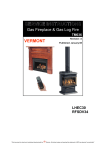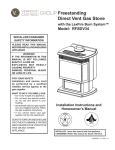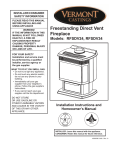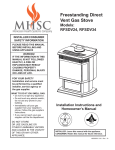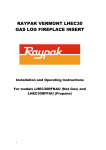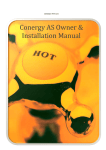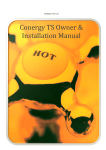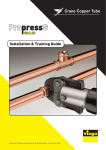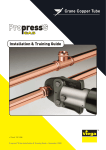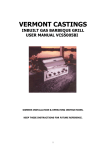Download Raypak RFSDV34RFNAU Operating instructions
Transcript
RAYPAK VERMONT RFSDV34 FREESTANDING GAS LOG FIRE Installation and Operating Instructions For Models RFSDV34RFNAU (Natural Gas) & RFSDV34RFPAU (Propane) Page 1 of 27 CONTENTS Part 1: For Your Safety Part 2: Installation Instructions • • • • • • • • Part 3: General Venting Information • • • • Part 4: Part 6: Termination Clearances General Information for Assembling Vent Pipes Vertical Through Roof Applications Install Vertical Venting Operating Instructions • • • • • • • • • Part 5: Start Up Recommendations Locating The Fireplace Clearance to Combustibles Fireplace Dimensions Gas Specifications Gas Inlet and Manifold Pressures Preparation Gas Line Installation General Glass Information Window Frame Assembly Removal Glass Cleaning Log Set and Lava Rock Installation Maintenance Flame and Temperature Adjustment Flame Appearance Remote Control Options RFSDV34 Lighting Instructions Troubleshooting • Troubleshooting the Gas Control System Replacement Parts List • Replacement Parts – drawing and list Page 2 of 27 Part 7: Conversion • Gas Type Conversion Instruction Part 8: Wiring Diagram • Wiring Diagram Part 9: Page 3 of 27 Warranty Part 1: For Your Safety For your safety do not operate this appliance before reading this instruction book. Warning: Improper installation, adjustment, alteration, service or maintenance can cause injury or property damage. For assistance or additional information consult with Raypak Australia, your Raypak distributor, qualified installer or accredited Rheem Australia Service Agency. WHAT TO DO IF YOU SMELL GAS? DO NOT try to light any gas appliance. DO NOT touch any electrical switch. Turn off gas supply at the meter. Immediately call Rheem Service, your gas supplier or licensed gasfitter. Note: Some gases are heavier than air and it maybe necessary to check for gas leaks at floor level. CAUTION! DO NOT operate this appliance before reading this instruction booklet. DO NOT place articles or objects on or against the appliance. DO NOT store chemicals or flammable materials in the same room as this appliance. DO NOT store chemicals or flammable materials on, or spray aerosols near this appliance. DO NOT operate with panels, covers or guards removed from the appliance. Page 4 of 27 Part 2: Installation Instructions This gas fireplace must be installed by a qualified installer in accordance with AS5601 and all relevant local building codes. For safe installation and operation please note the following: 1. This fireplace gives off high temperatures and should be located out of high traffic areas and away from furniture and draperies. 2. Children and adults should be alerted to the hazards of fireplace high surface temperatures and should stay away to avoid burns or ignition of clothing. 3. CAUTION: Due to high glass surface temperatures children should be carefully supervised when in the same room as the appliance. 4. Under no circumstances should this fireplace be modified or altered. Parts removed for servicing should be replaced prior to operating this fireplace again. 5. Installation and any repairs to this fireplace must be performed by a qualified installer, service agency or service person. A qualified service person should be contacted to inspect the fireplace annually. 6. Control compartments, burners and air passages in this fireplace should be kept clean and free of dust and lint. Make sure that the gas valve and pilot light are turned off before you attempt to clean this appliance. 7. The flueing system should be checked once a year and cleaned if required. 8. Keep the area surrounding this appliance clear of combustible materials, gasoline and other flammable vapour and liquids. This heater should not be used as a drying rack for clothing. 9. Under no circumstances should any solid fuels (wood, paper, coal or cardboard etc.) be used in this appliance. 10. The flow of combustion and ventilation air must not be obstructed in any way. 11. When this appliance is installed directly on carpeting, vinyl tile, linoleum or any combustible material other than wood, this fireplace must be installed on a metal or panel extending the full width and depth of the appliance. 12. This appliance requires adequate ventilation and combustion air to operate properly – refer to AS5601 ventilation and combustion air requirements. 13. This appliance must not be connected to a chimney flue serving a separate solid fuel burning fireplace. 14. When the fireplace is not in use it is recommended that the gas control valve be left in the OFF position. Page 5 of 27 IMPORTANT: PLEASE READ THE FOLLOWING CAREFULLY Remove any plastic from trim parts before turning the appliance on. It is normal for fireplaces fabricated of steel to give off some expansion and/or contraction noises during the start up or cool down cycle. It is not unusual for the Raypak Vermont gas fireplace to produce some odour the first time it is burned. This is due to residual oils used during the manufacturing process. Please open all windows to ensure your room is well ventilated. It is recommended that you burn your fireplace for at least 10 hours the first time you use it. Please turn the fan switch in the OFF position during this initial firing. Fig. 1 Locating Your Gas Fireplace A) Flat on wall* D) Cross corner B) Room divider* E) Flat on wall corner C) Island Warning: There is a minimum vertical rise required for the venting, which varies depending on the application. The maximum horizontal run also has restrictions. Before starting the installation read the venting instructions in this booklet and refer to AS5601. The minimum vertical rise for this appliance is 3m. Clearance to Combustibles: Adequate clearances as listed below must be maintained for servicing and proper operation. Back…………………………0 mm Side………………………305 mm Floor………………………...0 mm Top……………………….915 mm Corner………………………0 mm Flue Pipe………………….25 mm Page 6 of 27 DIMENSION A B C D E F G H I J K Page 7 of 27 RFSDV34 667mm 800mm 492mm 762mm 254mm 394mm 114mm 667mm 333mm 495mm 162mm Gas Specifications Model Gas Type Gas Control RFSDV34RFN RFSDV34RFP Natural Propane Radio Freq. Radio Freq. Min. MJ/h Input 22 24 Max. MJ/h Input 32 32 Gas Inlet and Burner Pressures Inlet Minimum Inlet Maximum Burner Pressure Natural Gas 1.1 kPa 3.50 kPa 0.87 kPa ULPG 2.75 kPa 3.50 kPa 2.50 kPa Preparation Warning: The use of wall paper adjacent to this fireplace is not recommended, as the heat produced by this appliance may adversely affect the binders in the adhesive used to apply the wall paper. Before beginning, remove the window frame assembly from the heater and ensure that there is not hidden damage to the heater. Take some time to plan the fitting line, flue and electrical supply. On completion of the installation ensure that the appliance is commissioned and tested. Fitting Line Installation Warning: When purging the fitting line, the front glass must be removed. Note: For pipe sizing requirements refer to Australian Standard AS5601 Gas Installations. If gas fitting line has been previously completed, check that the gas fitting line is of adequate size. Refer to Australian Standard AS5601 Gas Installations. The gas fitting line can be brought in through the rear or the bottom of the appliance. Openings are provided on the bottom behind the valve to allow for the gas fitting line installation and testing of any gas connection. It preferable to bring the fitting line in from the rear right side of the valve as this allows fan installation or removal without the need to disconnect the gas fitting line. Page 8 of 27 Note: When making the gas connection to the appliance inlet fitting, hold the 10mm 3/8” BSP fitting with a spanner when tightening the gas inlet pipe compression nut. For Propane installations an approved gas regulator must be fitted in accordance with AS5601. Ensure copper tube meets the requirements of Australian Standard AS1432 Type B. Note: Heater must be tested for correct operation by the installer after installation is complete. Page 9 of 27 Part 3: General Flue Installation Underside of gas cowl must be at least 500mm above highest point of the roof. This appliance is approved for an installation with a maximum flue height of 12m and a minimum flue height of 3m. Suspend a plumbline from the ceiling to the centre of the flue spigot. Mark the centre of the flue spigot on the ceiling. Prior to cutting the ceiling ensure that there is at lease 25mm clearance from any combustible materials. Fit ceiling ring, flue and flue cover. Page 10 of 27 Part 4: Operating Instructions NOTE: Carbon deposits maybe present on the glass and logs. This is normal and must be cleaned when the heater is serviced or the glass door is cleaned. Please refer to the General Glass Information section on page 15. General Glass Information Warning: Only glass approved for use by Raypak Australia may be used for replacement. The use of substitute glass will void all warranties. Take care to avoid breaking the glass. Warning: Under no circumstances is this appliance to be operated without the front glass or with a broken glass. Replacement of the glass including the gasket as supplied by Raypak Australia should be done by a licensed and qualified service person. Window Frame Assembly Removal 1. 2. 3. 4. 5. 6. Shut off gas. (see lighting instructions) If the unit has been operating, let it cool. Open the two side doors. Open the clamps on the two sides (Fig. 2) Pull the frame forward. To re-install window frame assembly, follow the above procedure in reverse Fig. 2 Window frame removal Glass Cleaning It is necessary to periodically clean condensation and film from the glass. Condensation, which is normal during start up, forms on the inside of the Page 11 of 27 glass and causes lint, dust and other air-borne particles to cling. Initial paint curing may also deposit a slight film on the glass. Clean the glass two or three times with a non-ammonia based household cleaner and warm water. (We recommend gas fireplace glass cleaner.) After the initial cleaning, clean the glass two or three times during each operating season, depending on the environment. Log Set and Lava Rock Material Installation 1. Remove window frame assembly. (See window frame removal assembly section) 2. Remove logs from packaging. Warning: Plastic bags are not toys and should be kept away from children and infants. 3. Place rear log (KR10) on rear bracket (ensure log is seated. properly, levelled and centred to the unit), so it will not move from side to side and is firmly positioned on the bracket. 4. Slip front ember log (KR7) down behind the front deflector. 5. Place front left log (KR8) on top of burner, left side. Using the bottom holes in the log, locate it into the left bracket log locator studs. 6. Place front right log (KR9) on top of burner, right side. Use the log’s bottoms holes to locate it into the right bracket log locator studs. 7. Place burner lava rock on top of burner between the ember log and the two front logs. 8. Place top left log (KR11) onto locator notches. Ensure the log is secure. 9. Place top right log (KR12) onto locator notches. Ensure log is secure. Fig. 3 Logs for the RFSDV34 gas log fire Maintenance Raypak Australia recommends that this appliance is serviced by qualified and licensed Service Person at least once a year. For service repairs and maintenance, Contact Rheem Service on 131 031. Page 12 of 27 Flame and Temperature Adjustment The appliance is fitted with the Honeywell Radio Frequency control valve and all adjustments are performed with the use of a remote controller. See instructions packaged with the Remote Controller or refer to page 16 in this manual for operating instructions. Flame Appearance Periodically perform a visual check of the pilot and burner flames by comparing them to the illustrations below (refer to figures 4 and 5). If any flames appear to be abnormal, place a service call. Fig 4. DVT pilot flame Fig.5 RFSDV34 flames Lighting Instructions FOR YOUR SAFETY, READ BEFORE LIGHTING WARNING: If you do not follow these instructions exactly, a fire or explosion may result, causing property damage, personal injury or loss of life. A. This heater has a pilot which must be lit manually. To light the pilot, follow these instructions exactly. B. BEFORE LIGHTING, smell all around the heater area for gas. Be sure to smell next to the floor as some gas is heavier than air and will settle on the floor. C. What to do if you smell gas: • • Page 13 of 27 DO NOT try to light any fireplace. DO NOT touch any electrical switch. • • • DO NOT use any phone in the building. IMMEDIATELY call you gas supplier from a neighbour’s phone or a mobile phone outside the building. Follow the gas suppliers instructions. IF YOU CANNOT CONTACT YOU GAS SUPPLIER CALL THE FIRE BRIGADE. D. Use only your hand to push in or turn the gas control knob. Never use tools. If the knob will not push in or turn by hand, do not try to repair it; call a qualified service technician. Applying force or any attempted repair may result in a fire or explosion. E. Do not use this appliance if any part has been under water. Immediately call a qualified service technician to inspect the heater and to replace any part of the control system and any gas control which has been under water. Lighting Instructions 1. STOP!! Read the safety information above. 2. Turn off all electrical power to the appliance. 3. For RN/RP appliances, turn ON/OFF switch to OFF position or set the thermostat to the lowest setting. 4. Open control access panel. 5. Push in gas control knob slightly and turn it clockwise to the off position. Do not force knob. 6. Wait 5 minutes to allow any gas to clear. Then smell for gas, including near the floor. If you smell gas, STOP and follow step B in the safety information above. If you do not smell gas, go to the next step. 7. Remove the glass door before lighting the pilot. (See Glass Removal Section – page 10) 8. Visibly locate pilot next to the main burner. 9. Turn knob on gas control anti-clockwise to “PILOT” 10. Push the control knob all the way in and hold. Immediately light the pilot by repeatedly depressing the piezo spark ignitor until a flame appears. Continue to hold the knob in for about one (1) minute after the pilot is lit. Release knob and it will pop back up and pilot should remain lit. If it goes out repeat steps 5 through to 8. • • If control knob does not pop up when it is released, stop and immediately call Rheem service, your local service technician or your gas supplier. If after several attempts, the pilot will not stay lit, turn the gas control knob to OFF and call Rheem service, your local service technician or gas supplier. 11. Replace the glass door. 12. Turn the gas control knob to the ON position. Page 14 of 27 13. For the RN/RP models turn the remote control ON/OFF switch to the ON position or set the thermostat to the desired setting. 14. Turn on electrical supply. To Turn Off the Heater 1. Turn the remote control ON/OFF switch to OFF or set the thermostat to the lowest setting. 2. Turn off power supply to the appliance if a service is to be performed. 3. Open louvre assembly bottom. 4. Push in gas control knob slightly and turn clockwise to OFF. Do not force this knob. 5. Close control access panel. RFSDV34 Operating Instructions The comfort control valve (Fig 6) allows remote control of temperature, fan and flame appearance. To access the REMOTE/LOCAL switch on the comfort control valve; open the control door assembly, then remove the upper left and right hand screws on the control panel. Pull the panels forward to expose the gas valve. The REMOTE/LOCAL switch is located on the top of the gas valve. NOTE: The antenna should hang in free air away from grounded metal. Operation 1. If the manual switch is in the REMOTE position, switch it to LOCAL. 2. Turn the pilotstat knob anticlockwise from the OFF to the PILOT position, push the knob down and hold it in position. The pilot valve is now open and allows gas to flow to the pilot burner. 3. Push the plunger on the piezo ignitor until the pilot burner is lit. When the pilot burner is lit the LED on the control will come on after approximately 40 seconds and will provide 1 short blink continuously in the normal mode. When the light turns off, which will be approximately 10 seconds after it has been continuously red, the receiver valve is fully powered. 4. Release the knob (the shaft will move upward). The pilot light should stay lit. If the pilot burner goes out, repeat step 2. 5. Turn the knob anticlockwise to the ON position. If the manual switch is in the LOCAL position (step 1), the main burner will come on immediately. 6. Upon initial use of the remote control, a recognition operation is required between the receiver/valve and remote control. Change the switch from LOCAL to REMOTE . Press the fan or flame button on the Page 15 of 27 remote control within 30 seconds. The LED will blink indicating the remote control will now work with the receiver valve. If the switch continues in the REMOTE position, the remote control will now control the main valve, flame modulation level and fan control. 7. If the manual switch is in the LOCAL position, the valve will be at the highest fixed pressure setting and the fan will be at the highest fixed speed. The remote control will control the fan speed only. Fig. 6 Comfort Control Valve Shut Off Procedure If the manual switch is in the REMOTE position, the remote control can shut off the main burner and fan. However, if the control is still ON a command from the remote control can turn on the main burner or fan. To shut off the system, turn the pilotstat knob clockwise to the OFF position. This action closes the main gas and safety valves. The remote control cannot turn on the main burner or fan. Remote Control Operation Refer to Fig 7 OFF Mode In the OFF mode, the fireplace flame and fan are off, the display will show OFF and display the room temperature. If the receiver is in the REMOTE mode, the fireplace will shut off. ON Mode (Manual) In the ON mode, the room temperature, flame and fan levels will be shown. MANUAL will appear next to both the flame and fan icons. When the control is in the ON mode, you can change the flame and fan levels and the delay timer with the Up and Down buttons. To change the flame level, press the Flame button followed by an arrow key. To change the fan level, press the Fan key followed by an arrow key. Pushing the arrow key once changes the level by one unit Page 16 of 27 Fig.7 Transmitter diagram Delay Timer Mode The shut off delay timer maximum setting is 2 hours and minimum setting is zero minutes. To change the timer level, press the timer key, then the arrow key. Each key press changes the setting by 10 minutes. Auto Mode In the AUTO mode, the room temperature, set temperature, flame and fan levels will be shown. AUTO will appear next to both the flame and fan icons. With the control in AUTO mode, the main burner turns ON or OFF or modulates based on the heating differential needed to maintain the set temperature. The flame level adjusts automatically to optimize the heat output required to maintain the set temperature. To change the set temperature, press the UP or DOWN key. Each key press changes the setting by one degree. In the AUTO mode, the fan speed increases with increased fan height and decreases with the decreased fan height. “AUTO” is displayed next to the flame and fan icons. Fan Override During Auto Mode If a higher or lower fan speed is desired when operating in AUTO mode, override the fan speed by pressing the fan button, then the Up or Down key. Each key press changes the fan speed level by one unit. In this mode “AUTO” is displayed next to the flame icon and “MANUAL” is displayed next to the Fan icon. Change Between F° and C° Temperature Units Press the Up and Down arrow keys simultaneously for at least 3 seconds to switch between Fahrenheit and Celsius units. Disable Thermostat Function To disable the thermostat function in the AUTO mode, press the Timer and Down keys simultaneously for at least 3 seconds. Page 17 of 27 To Change Batteries 1. Remove cover on backside of the remote control. Install 3 AAA as shown on the cover and then re-attach the cover. 2. Once OPERATION steps 1 to 3 are completed, the receiver/valve and remote control are ready. Press any button on the remote control to initiate the recognition process between the receiver/valve and the remote control. 3. You may now use the functions as described in the REMOTE CONTROL section. Fig 8. Comfort control wiring diagram Part 5 Troubleshooting Refer to Fig 6 1. Locate the LED light on the gas valve. 2. LED will blink after every valid command received from the remote control; this is not an error. 3. Failure codes may occur anytime after the pilot burner is lit. 4. The sequence is: failure code followed by light not blinking for 30 seconds. 5. In the event of multiple failure codes, the next failure code follows previous failure code by approximately 3 seconds. If an error code 3 is observed while performing the testing, complete the following: 1. Make sure all the spade connectors are pushed all the way onto the terminals. If error code 3 still shows, go onto the next step. 2. Switch the two front thermopile leads with the back two. Be sure the white lead is connected to the spade marked with the white dot. If error code 3 still shows, replace the thermopiles. Page 18 of 27 If an error code 8 is observed while performing the testing, complete the following: 1. Confirm that the gas valve is not in the REMOTE mode. • If the valve is producing error code 8 while in the REMOTE mode, the valve is defective and should be replaced. • If the valve is producing error code 8 while in the LOCAL mode, go to the next step. 2. Slide the REMOTE/LOCAL switch to REMOTE and program the remote control as per item 6 page 13. The error code will clear itself after approximately 1.5 minutes and return to normal operation. Page 19 of 27 Troubleshooting the Gas Control System Comfort Valve System Control Sequence of Operation with Remote Control Local Path Set manual switch to local or remote Five minute wait period Light pilot burner Yes Did the LED stop blinking? Review LED failure analysis Release pilotstat knob Turn pilotstat knob to PILOT to turn off main burner Turn pilotstat knob to OFF to turn valve completely off. Cycle switch once and leave in remote. Press any key on the Remote Control for recognition operation. Turn pilotstat knob from PILOT to ON On Path If the manual switch is set to remote, press the mode button to display ON. Does the remote control the main burner and fan? Does remote control change levels of flame height, fan speed? Yes Set levels of flame height and fan to “0” to shut off main burner and fan Turn pilotstat knob to OFF to turn valve completely off Choose Manual or Remote path. Set switch to manual or remote. Auto Path Move switch from manual to remote. Press any key on remote control Yes Page 20 of 27 Move switch from manual to remote. Press any key on the remote control. Move switch back to If manual switch is set to LOCAL, did main burner light and fan turn on? No If the manual switch is set to remote, press the mode button to display AUTO. Does the remote control display the room and temperature settings? Move switch from local to remote. Press any key on remote control within 30 seconds If the setting is above room temperature on the remote control does the main valve and fan turn on? No If the setting is below room temperature on the remote control, does the main valve and fan turn off? No Turn pilotstat knob to OFF to turn valve completely off. Part 6 Replacement Parts List Insert replacement parts list and parts drawing here. Part 7 Conversion Instructions 1. Disconnect power to the unit and shut off the gas supply. 2. Remove the window frame assembly. (see the Window Frame Assembly section) 3. Carefully remove the logs. (ensure they are not hot) 4. Remove pilot assembly from bracket. 5. Remove the 2 screws holding the burner housing assembly in place. 6. Remove the burner housing assembly. 7. Remove the main and front orifice and replace with the orifice supplied in the conversion kit. Use the small orifice size for the front burner and the bigger orifice size for the main burner. 8. Remove the compression fitting which holds the aluminium tubing in the pilot assembly. This will reveal the pilot injector which must be replaced with the pilot injector provided in the conversion kit. 9. Honeywell Gas Valve -: The Honeywell valve fitted to this appliance is preset for Propane gas. It is convertible to natural gas by a colour coded “conversion screw”. To insert the conversion screw, refer to the instructions and diagrams in the Honeywell Installation Instructions supplied in the conversion kit packaged with the RFSDV34 unit. 10. Reassemble the fireplace in reverse order except for the window frame assembly. Leave the window frame assembly off until the unit has been checked for leaks and the gas supply has been purged. 11. After purging the gas line and checking for leaks with soapy water, replace the window frame assembly. Light the unit and check for frame impingement on logs, adjusting them if necessary. Check the manifold and supply pressures. NOTE: If further assistance is required, refer to the Troubleshooting and Parts List in this manual. Page 21 of 27 Wiring Diagram A N Part 8 240V AC Terminal Block Fuse - 3 Amp Transformer 240V AC - 110V AC 2A (50VA) Speed Control 240V AC 50 Hz Main Heater Supply High Limit Fan RFSDV34 GAS LOG FIRE WIRING DIAGRAM Page 22 of 27 Page 23 of 27 Page 24 of 27 Page 25 of 27 Part 9 Warranty RAYPAK RFSDV34RFN & RFSDV34RFP FREESTANDING GAS LOG FIRE WARANTY - AUSTRALIA ONLY – Rheem Australia * will: a) Repair or, if necessary replace any Raypak RFSDV34 Freestanding Gas Log Fire, or b) Replace any component (or, if necessary, arrange the installation of a Raypak Gas Log Fire, which falls within the Warranty Periods specified below, in accordance with and subject table, conditions and exclusions. Installation Models From date of installation Freestanding RFSDV34RFN & Gas Log Fire RFSDV34RFP Period Warranty Year 1 Labour Freestanding Gas Log Fire RFSDV34RFN & RFSDV34RFP Years 2 Parts Fan and other components Freestanding Gas Log Fire RFSDV34RFN & RFSDV34RFP Years 10 Parts This warranty covers the appliance heat exchanger for 10 years pro-rata with a 1 year labour warranty. Notes: * Rheem Australia Pty Ltd provides warranty service and spare parts on behalf of Raypak Australia Pty. Ltd. ** Refer to item 5 of warranty conditions. Rheem reserves the right to transfer fully functional components from the defective gas log fire to the replacement appliance if required. In addition to this warranty, the Trade Practices Act 1974 and similar laws in each state and territory provide the owner under certain circumstances with certain minimum statutory rights in relation to your Raypak gas log fire. This warranty must be read subject to that legislation and nothing in this warranty has the effect of excluding, restricting or modifying those rights. Rheem Australia Pty Ltd A.B.N 21 098 823 511 Raypak Australia Pty Ltd A.B.N 65 078 743 414 Page 26 of 27 FOR SERVICE TELEPHONE 131 031 AUSTRALIA or refer to your local yellow pages RAYPAK MAJESTIC RFSDV34RFNAU AND RFSD34RFPAU WARRANTY - AUSTRALIA ONLY – WARRANTY CONDITIONS 1. 2. 3. 4. 5. 6. This warranty is applicable only to the RFSDV34RFN and the RFSDV34RFP gas log fires manufactured from August 2005 The gas log fire must be installed in accordance with the Raypak installation instructions, supplied with the appliance and in accordance with all relevant statutory and local requirements of the State in which the appliance is installed. This gas log fire must be correctly commissioned by a licensed and authorised person and the installation certified by the relevant Gas Authority of the State in which the appliance is installed. Where a failed component or appliance is replaced under warranty, the balance of the original warranty period will remain effective. The replaced part of appliance does not carry a new warranty. Where the gas log fire is installed outside the boundaries of the metropolitan area as defined by Rheem or further than 25 km from a regional Rheem branch office, or an accredited service agent, the cost of transport, insurance and travelling costs between the nearest Rheem accredited Service Agent’s premises and the installed site shall be owner’s responsibility. The warranty only applies to the gas log fire and original or genuine (company) component replacement parts and therefore does not cover any plumbing or electrical parts supplied by the installer and not an integral part of the appliance. Page 27 of 27



























